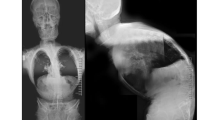Abstract
Purpose
Thoraco-lumbar kyphosis (TLK) is poorly described in the literature and its surgical treatment remains equivocal for patients with low pelvic incidence. The aim of the study was to identify which surgical correction would yield the best functional results as measured by the Oswestry score.
Materials and methods
This is a retrospective study including patients described as a type 1 of Roussouly’s classification with a thoraco-lumbar kyphosis. Fifty-six patients with degenerative spinal disease were included, 42 (75%) with scoliosis and 14 (25%) without. Patients had a median age of 56 years (49–63), and there were 6 (11%) men. The primary outcome was the functional Oswestry disability index (ODI).
Results
At last follow-up, the median ODI was 15 (Q1–Q3: 6–23). In the degenerative spinal disease group, the median ODI was 7 (3.5–20) at last follow-up. Ten (84%) patients were classified as Roussouly’s type 1 after surgery. In the degenerative scoliosis group, the ODI was 17 (8–23) in patients classified as Roussouly’s type 1 and 20 (7.5–25) in patients classified as Roussouly’s type 2 with no significant difference between these groups (p = 1). There were two patients classified as Roussouly’s type 3a and their ODI at last follow-up were of 60 and 50.
Conclusion
It seems that keeping the physiological morphology is the treatment of choice. For patients with degenerative scoliosis, reducing the kyphosis could work. We do not recommend to increase the lordosis and obtain a type 3 morphology with an anteverted pelvis because of the risk of PJK and poor functional results.



Similar content being viewed by others
References
Diebo BG, Varghese JJ, Lafage R et al (2015) Sagittal alignment of the spine: what do you need to know? Clin Neurol Neurosurg 139:295–301. doi:10.1016/j.clineuro.2015.10.024
Diebo BG, Henry J, Lafage V, Berjano P (2014) Sagittal deformities of the spine: factors influencing the outcomes and complications. Eur Spine J 24:3–15. doi:10.1007/s00586-014-3653-8
Takemoto M, Boissière L, Novoa F et al (2016) Sagittal malalignment has a significant association with postoperative leg pain in adult spinal deformity patients. Eur Spine J. doi:10.1007/s00586-016-4616-z
Koller H, Pfanz C, Meier O et al (2016) Factors influencing radiographic and clinical outcomes in adult scoliosis surgery: a study of 448 European patients. Eur Spine J 25:532–548. doi:10.1007/s00586-015-3898-x
Lenke LG, Betz RR, Harms J et al (2001) Adolescent idiopathic scoliosis: a new classification to determine extent of spinal arthrodesis. J Bone Joint Surg Am 83-A:1169–1181
Lowe T, Berven SH, Schwab FJ, Bridwell KH (2006) The SRS classification for adult spinal deformity: building on the King/Moe and Lenke classification systems. Spine 31:S119–S125. doi:10.1097/01.brs.0000232709.48446.be
Schwab FJ, Smith VA, Biserni M et al (2002) Adult scoliosis: a quantitative radiographic and clinical analysis. Spine 27:387–392
Schwab F, Ungar B, Blondel B et al (2012) Scoliosis Research Society-Schwab adult spinal deformity classification: a validation study. Spine 37:1077–1082. doi:10.1097/BRS.0b013e31823e15e2
Schwab F, Lafage V, Farcy J-P et al (2007) Surgical rates and operative outcome analysis in thoracolumbar and lumbar major adult scoliosis: application of the new adult deformity classification. Spine 32:2723–2730. doi:10.1097/BRS.0b013e31815a58f2
Roussouly P, Gollogly S, Berthonnaud E, Dimnet J (2005) Classification of the normal variation in the sagittal alignment of the human lumbar spine and pelvis in the standing position. Spine 30:346–353
Roussouly P, Pinheiro-Franco JL (2011) Biomechanical analysis of the spino-pelvic organization and adaptation in pathology. Eur Spine J 20(suppl 5):609–618. doi:10.1007/s00586-011-1928-x
Roussouly P, Labelle H, Rouissi J, Bodin A (2013) Pre- and post-operative sagittal balance in idiopathic scoliosis: a comparison over the ages of two cohorts of 132 adolescents and 52 adults. Eur Spine J 22(suppl 2):S203–S215. doi:10.1007/s00586-012-2571-x
Fairbank JCT, Pynsent PB (2000) The Oswestry disability index. Spine 25:2940–2953. doi:10.1097/00007632-200011150-00017
Barrey C, Jund J, Noseda O, Roussouly P (2007) Sagittal balance of the pelvis-spine complex and lumbar degenerative diseases. A comparative study about 85 cases. Eur Spine J 16:1459–1467. doi:10.1007/s00586-006-0294-6
Ferrero E, Vira S, Ames CP et al (2015) Analysis of an unexplored group of sagittal deformity patients: low pelvic tilt despite positive sagittal malalignment. Eur Spine J. doi:10.1007/s00586-015-4048-1
Tyrakowski M, Mardjetko S, Siemionow K (2014) Radiographic spinopelvic parameters in skeletally mature patients With Scheuermann Disease. Spine 39:E1080–E1085. doi:10.1097/BRS.0000000000000460
Nasto LA, Perez-Romera AB, Shalabi ST et al (2016) Correlation between preoperative spinopelvic alignment and risk of proximal junctional kyphosis after posterior-only surgical correction of Scheuermann kyphosis. Spine J 16:S26–S33. doi:10.1016/j.spinee.2015.12.100
Kim HJ, Lenke LG, Shaffrey CI et al (2012) Proximal junctional kyphosis as a distinct form of adjacent segment pathology after spinal deformity surgery. Spine 37:S144–S164. doi:10.1097/BRS.0b013e31826d611b
Takemoto M, Boissière L, Vital J-M et al (2016) Are sagittal spinopelvic radiographic parameters significantly associated with quality of life of adult spinal deformity patients? Multivariate linear regression analyses for pre-operative and short-term post-operative health-related quality of life. Eur Spine J. doi:10.1007/s00586-016-4872-y
Glassman SD, Coseo MP, Carreon LY (2016) Sagittal balance is more than just alignment: why PJK remains an unresolved problem. Scoliosis Spinal Disord. doi:10.1186/s13013-016-0064-0
Author information
Authors and Affiliations
Corresponding author
Ethics declarations
Conflict of interest
The authors declared that they have no potential conflict of interest.
Rights and permissions
About this article
Cite this article
Scemama, C., Laouissat, F., Abelin-Genevois, K. et al. Surgical treatment of thoraco-lumbar kyphosis (TLK) associated with low pelvic incidence. Eur Spine J 26, 2146–2152 (2017). https://doi.org/10.1007/s00586-017-4984-z
Received:
Revised:
Accepted:
Published:
Issue Date:
DOI: https://doi.org/10.1007/s00586-017-4984-z




